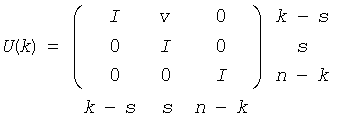Developer Reference for Intel® oneAPI Math Kernel Library for C
A newer version of this document is available. Customers should click here to go to the newest version.
?sytrf
Computes the Bunch-Kaufman factorization of a symmetric matrix.
lapack_int LAPACKE_ssytrf (int matrix_layout , char uplo , lapack_int n , float * a , lapack_int lda , lapack_int * ipiv );
lapack_int LAPACKE_dsytrf (int matrix_layout , char uplo , lapack_int n , double * a , lapack_int lda , lapack_int * ipiv );
lapack_int LAPACKE_csytrf (int matrix_layout , char uplo , lapack_int n , lapack_complex_float * a , lapack_int lda , lapack_int * ipiv );
lapack_int LAPACKE_zsytrf (int matrix_layout , char uplo , lapack_int n , lapack_complex_double * a , lapack_int lda , lapack_int * ipiv );
- mkl.h
The routine computes the factorization of a real/complex symmetric matrix A using the Bunch-Kaufman diagonal pivoting method. The form of the factorization is:
if uplo='U', A = U*D*UT
if uplo='L', A = L*D*LT
where A is the input matrix, U and L are products of permutation and triangular matrices with unit diagonal (upper triangular for U and lower triangular for L), and D is a symmetric block-diagonal matrix with 1-by-1 and 2-by-2 diagonal blocks. U and L have 2-by-2 unit diagonal blocks corresponding to the 2-by-2 blocks of D.
matrix_layout |
Specifies whether matrix storage layout is row major (LAPACK_ROW_MAJOR) or column major (LAPACK_COL_MAJOR). |
uplo |
Must be 'U' or 'L'. Indicates whether the upper or lower triangular part of A is stored and how A is factored: If uplo = 'U', the array a stores the upper triangular part of the matrix A, and A is factored as U*D*UT. If uplo = 'L', the array a stores the lower triangular part of the matrix A, and A is factored as L*D*LT. |
n |
The order of matrix A; n≥ 0. |
a |
Array, size max(1, lda*n). The array a contains either the upper or the lower triangular part of the matrix A (see uplo). |
lda |
The leading dimension of a; at least max(1, n). |
a |
The upper or lower triangular part of a is overwritten by details of the block-diagonal matrix D and the multipliers used to obtain the factor U (or L). |
ipiv |
Array, size at least max(1, n). Contains details of the interchanges and the block structure of D. If ipiv[i-1] = k >0, then dii is a 1-by-1 block, and the i-th row and column of A was interchanged with the k-th row and column. If uplo = 'U' and ipiv[i] =ipiv[i-1] = -m < 0, then D has a 2-by-2 block in rows/columns i and i+1, and i-th row and column of A was interchanged with the m-th row and column. If uplo = 'L' and ipiv[i] =ipiv[i-1] = -m < 0, then D has a 2-by-2 block in rows/columns i and i+1, and (i+1)-th row and column of A was interchanged with the m-th row and column. |
This function returns a value info.
If info = 0, the execution is successful.
If info = -i, parameter i had an illegal value.
If info = i, Dii is 0. The factorization has been completed, but D is exactly singular. Division by 0 will occur if you use D for solving a system of linear equations.
The 2-by-2 unit diagonal blocks and the unit diagonal elements of U and L are not stored. The remaining elements of U and L are stored in the corresponding columns of the array a, but additional row interchanges are required to recover U or L explicitly (which is seldom necessary).
If ipiv[i-1] = i for all i =1...n, then all off-diagonal elements of U (L) are stored explicitly in the corresponding elements of the array a.
If uplo = 'U', the computed factors U and D are the exact factors of a perturbed matrix A + E, where
|E| ≤ c(n)ε P|U||D||U T |P T
c(n) is a modest linear function of n, and ε is the machine precision. A similar estimate holds for the computed L and D when uplo = 'L'.
The total number of floating-point operations is approximately (1/3)n3 for real flavors or (4/3)n3 for complex flavors.
After calling this routine, you can call the following routines:
to solve A*X = B |
|
to estimate the condition number of A |
|
to compute the inverse of A. |
If uplo = 'U', then A = U*D*U', where
U = P(n)*U(n)* ... *P(k)*U(k)*...,
that is, U is a product of terms P(k)*U(k), where
k decreases from n to 1 in steps of 1 and 2.
D is a block diagonal matrix with 1-by-1 and 2-by-2 diagonal blocks D(k).
P(k) is a permutation matrix as defined by ipiv[k-1].
U(k) is a unit upper triangular matrix, such that if the diagonal block D(k) is of order s (s = 1 or 2), then

If s = 1, D(k) overwrites A(k,k), and v overwrites A(1:k-1,k).
If s = 2, the upper triangle of D(k) overwrites A(k-1,k-1), A(k-1,k) and A(k,k), and v overwrites A(1:k-2,k -1:k).
If uplo = 'L', then A = L*D*L', where
L = P(1)*L(1)* ... *P(k)*L(k)*...,
that is, L is a product of terms P(k)*L(k), where
k increases from 1 to n in steps of 1 and 2.
D is a block diagonal matrix with 1-by-1 and 2-by-2 diagonal blocks D(k).
P(k) is a permutation matrix as defined by ipiv(k).
L(k) is a unit lower triangular matrix, such that if the diagonal block D(k) is of order s (s = 1 or 2), then

If s = 1, D(k) overwrites A(k,k), and v overwrites A(k+1:n,k).
If s = 2, the lower triangle of D(k) overwrites A(k,k), A(k+1,k), and A(k+1,k+1), and v overwrites A(k+2:n,k:k+1).